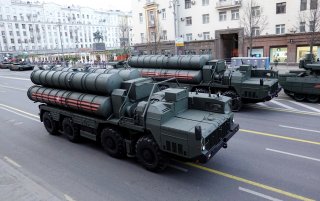Russia Deployed S-400 Surface-to-Air Missile in Recent Drills
India is among the latest countries to sign a deal with Moscow to acquire the platform.
This week the Russian military employed the S-400 “Trimuf” surface-to-air missile system in a live-fire exercise during drills in the south Astrakhan Region involving the Central Military District’s air defense division. The drills involved more than 450 Russian military personnel and some two hundred pieces of military hardware.
The combat teams also passed theory tests in technical, tactical and missile firing measures, while the live-fire exercise was conducted as part of the Central Military District’s large scale air defense drills that involved more than ten thousand troops in total.
“As part of the practice stage with a live-fire exercise, the teams of S-400 ‘Triumf’ systems and Pantsyr-S1 anti-aircraft missile/gun launchers repelled a notional enemy’s simulated massive missile and air strike by launching missiles,” the Central Military District’s press office told Tass on Tuesday. “As a result, all the targets designated for their destruction were struck in accordance with the required procedures.”
According to reports, Strizh-M, Favorit and Kaban aerial missile targets and Armavir low-altitude target missiles were used to create a combat training environment and simulate an air attack.
“During the drills, the units of anti-aircraft missile regiments also went on combat duty for air defense in a new positioning area, made a march to temporary on-duty positions after overcoming notionally contaminated terrain sections and carried out a set of measures for camouflaging combat hardware,” the press office added.
The Russia-built S-400 Triumf (NATO reporting name: SA-21 Growler) is the latest long-and medium-range surface-to-air missile system and it is designed to destroy aircraft, cruise and ballistic missiles, and can also be used against ground installations. The S-400, which can also launch 40N6 missiles, is designed to engage targets at a distance of up to four hundred kilometers at up to six times the speed of sound, and at an altitude of up to thirty kilometers under intensive enemy fire and jamming. It entered service in 2007.
The S-400 has also been seen as a significant improvement over its S-300 predecessor on several performance fronts. Whereas the S-300 was explicitly designed as a long-range air defense system, the S-400 is currently compatible with four missiles that are meant to satisfy a wide spectrum of operational categories: very long-range 40N6E (400 kilometers), long-range 48N6 (250 kilometers), medium-range 9M96e2 (120 kilometers) and short-range 9m96e (40 kilometers).
In June it was announced that the Russian military would receive an additional three regiments of the S-400 anti-aircraft missile systems, along with four sets of the S-350 “Vityaz” battlefield air defense launchers by 2023 under new contracts with the Almaz-Antey defense manufacturer.
The S-400 is also being widely exported—much to the chagrin of the United States and NATO. The United States has even imposed economic sanctions on countries simply for buying the system, but many of the world’s powers have still expressed interest in it. The use of the S-400 as an economic warfare tool should not be underestimated as the platform is an example of Russian Hybrid Warfare against the United States and NATO.
India is among the latest countries to sign a deal with Moscow to acquire the platform. Last month, New Delhi agreed to a $5 billion deal to buy five units of the air defense missile system, and this follows Saudi Arabia’s agreement to purchase the system earlier this year.
Earlier this year Russia and Turkey also entered an advanced stage of talks for the delivery of the second regiment set of the S-400 systems to Ankara. Moreover, Russia was apparently ready to discuss the possibility of technological cooperation with Turkey, which could imply the participation of Turkish companies. However, in July, Moscow abruptly suspended further S-400 delivers to the People’s Republic of China (PRC), so why Russia has looked for foreign buyers of the platform potential customers may include those in Beijing.
Peter Suciu is a Michigan-based writer who has contributed to more than four dozen magazines, newspapers and websites. He is the author of several books on military headgear including A Gallery of Military Headdress, which is available on Amazon.com.
Image: Reuters

